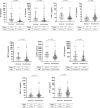Clinical, laboratory data and inflammatory biomarkers at baseline as early discharge predictors in hospitalized SARS-CoV-2 infected patients
- PMID: 35834501
- PMCID: PMC9282584
- DOI: 10.1371/journal.pone.0269875
Clinical, laboratory data and inflammatory biomarkers at baseline as early discharge predictors in hospitalized SARS-CoV-2 infected patients
Erratum in
-
Correction: Clinical, laboratory data and inflammatory biomarkers at baseline as early discharge predictors in hospitalized SARS-CoV-2 infected patients.PLoS One. 2024 Nov 21;19(11):e0314574. doi: 10.1371/journal.pone.0314574. eCollection 2024. PLoS One. 2024. PMID: 39570969 Free PMC article.
Abstract
Background: The SARS-CoV-2 pandemic has overwhelmed hospital services due to the rapid transmission of the virus and its severity in a high percentage of cases. Having tools to predict which patients can be safely early discharged would help to improve this situation.
Methods: Patients confirmed as SARS-CoV-2 infection from four Spanish hospitals. Clinical, demographic, laboratory data and plasma samples were collected at admission. The patients were classified into mild and severe/critical groups according to 4-point ordinal categories based on oxygen therapy requirements. Logistic regression models were performed in mild patients with only clinical and routine laboratory parameters and adding plasma pro-inflammatory cytokine levels to predict both early discharge and worsening.
Results: 333 patients were included. At admission, 307 patients were classified as mild patients. Age, oxygen saturation, Lactate Dehydrogenase, D-dimers, neutrophil-lymphocyte ratio (NLR), and oral corticosteroids treatment were predictors of early discharge (area under curve (AUC), 0.786; sensitivity (SE) 68.5%; specificity (S), 74.5%; positive predictive value (PPV), 74.4%; and negative predictive value (NPV), 68.9%). When cytokines were included, lower interferon-γ-inducible protein 10 and higher Interleukin 1 beta levels were associated with early discharge (AUC, 0.819; SE, 91.7%; S, 56.6%; PPV, 69.3%; and NPV, 86.5%). The model to predict worsening included male sex, oxygen saturation, no corticosteroids treatment, C-reactive protein and Nod-like receptor as independent factors (AUC, 0.903; SE, 97.1%; S, 68.8%; PPV, 30.4%; and NPV, 99.4%). The model was slightly improved by including the determinations of interleukine-8, Macrophage inflammatory protein-1 beta and soluble IL-2Rα (CD25) (AUC, 0.952; SE, 97.1%; S, 98.1%; PPV, 82.7%; and NPV, 99.6%).
Conclusions: Clinical and routine laboratory data at admission strongly predict non-worsening during the first two weeks; therefore, these variables could help identify those patients who do not need a long hospitalization and improve hospital overcrowding. Determination of pro-inflammatory cytokines moderately improves these predictive capacities.
Conflict of interest statement
The authors have declared that no competing interests exist.
Figures




References
-
- COVID-19 Map. Johns Hopkins Coronavirus Resource Center. Available: https://coronavirus.jhu.edu/map.html
Publication types
MeSH terms
Substances
LinkOut - more resources
Full Text Sources
Medical
Research Materials
Miscellaneous

